Leeds City Museum
Leeds City Museum, originally established in 1819, reopened in 2008 in Leeds, West Yorkshire, England. It is housed in the former Mechanics' Institute built by Cuthbert Brodrick, in Cookridge Street (now Millennium Square), which has been redeveloped to a design by Austin-Smith:Lord architects and Buro Happold engineers. Gallery and exhibit design is provided by Redman Design. It one of nine sites in the Leeds Museums & Galleries group.
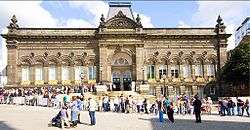 Leeds City Museum | |
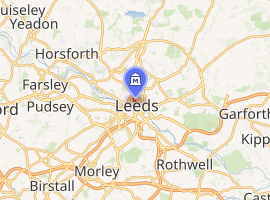
| |
| Established | 1819; reopened 13 September 2008 |
|---|---|
| Location | Millennium Square, Leeds, West Yorkshire, England. |
| Coordinates | 53.801617°N 1.547323°W |
| Type | Collection (museum), Heritage centre |
| Public transit access | Leeds railway station, Leeds City bus station |
| Website | Leeds City Museum |
Admission to the museum is free of charge. Special exhibitions are hosted alongside a collection of displays from the Leeds Archive.
History
In 1819, a museum was established in Philosophical Hall, Bond Street, by the Leeds Philosophical and Literary Society, and in 1821 it opened to the public. In 1921, control of the museum was handed to the Corporation of Leeds which later became Leeds City Council. In 1862, Philosophical Hall was rebuilt in Park Row, where its stone portico can still be seen on the west side of the road.[1] In 1941, the museum building and artifacts were badly damaged by bombing. In 1965 the museum was closed, and a few exhibits removed to a couple of rooms in the city library in 1966. The oversized Leeds Tiger, the giant moose skeleton and the carved wooden cart took up much of the space. In 1999 the museum went into storage, though researchers and the public could view items by appointment. In 2000, the resource centre at Yeadon opened, under the same appointment-to-view arrangement. In 2001, Leeds City Council bid for National Lottery cash, and in 2004, it was awarded £19.5 million,[2] so in 2005, the Leeds Mechanics' Institute building began to be redesigned as Leeds City Museum, finally to reopen in 2008.[3]
The exhibits
While exhibits vary, they are mainly made up of exhibits from Leeds' history. The central hall has a large map of Leeds printed on the floor. There is also a scale model of the Quarry Hill flats. The exhibits are organised among several galleries.
Life on Earth gallery
This is the natural history gallery, featuring everything from a meteorite to dinosaur poo (coprolite). In 2019, the skeleton of a Long-finned Pilot Whale was hung from the ceiling just outside the gallery.[4]
Leeds Tiger
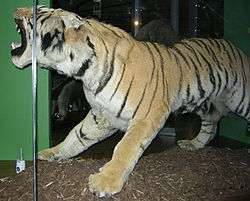
A large, stuffed Bengal tiger, this exhibit came to Leeds in 1862. It was shot by Colonel Charles Reid in Dehra Dun, Utta Pradesh, India in March, 1860. It was originally exhibited at the London International Exhibition as a tiger rug - hence its odd shape - before being turned into a taxidermy mount by Henry Ward. The Leeds Philosophical and Literary Society commissioned Ward to do this work and it has been on display to the people of Leeds almost continuously for over 150 years.[5][6][7]
The tiger was one of the foremost attractions in Leeds as soon as it was exhibited. At the annual conversazione of the Leeds Philosophical Society in 1863, the Reverend T. Hincks stated that "he was afraid that the tiger ... had been too much the great lion ... and that they had neglected many other noble beasts surrounding it."[8] This exhibit - so beloved of the Leeds populace - has a strange history. It was a tiger skin rug when purchased for £90 and presented to the Museum by William Gott in the 19th century.[9][10] The present exhibit was likely constructed of more than one tiger skin because: "researcher Ebony Andrews believes that the skin might have been trimmed after it was tanned, leaving missing sections underneath the tiger's chin, neck and up all four legs."[11]
Museum records give the impression that the tiger had been shot for spending too much time near a village in India.[11][12] Meanwhile, the story of a tiger shot for its mere presence at the edge of a village became a legend of the killer of one man, then of two people, then the serial killer of forty.[13] This myth may have developed following a 1906 guidebook by Henry Crowther, which said it "destroyed forty bullocks in six weeks and was considered so formidable that no native dare venture into the jungle where this noble beast reigned supreme." The Yorkshire Evening Post said, "We'll never know for certain whether the Leeds Tiger really lived up to its dangerous reputation, but today it sends a shiver down the spines of visitors to Leeds City Museum."[11] However the pelt may now be dangerous after all, in a sense, as the Victorians will have preserved it with arsenical soap.[14][15][16] For over a century it has sagged somewhat, as can be seen in the photograph. Nevertheless, in the early 1860s the tiger was considered an object of beauty:[10][17]
The setting up of this tiger is so natural and so perfect in posture and anatomical detail, that it is certainly to be looked upon as a work of art quite as much as an object for scientific observation ... [17] Professor Owen has more than once stated that it is the finest and largest animal of its species not only in England but in Europe.[10]
It has been said that the tiger was "saved from the curators' skip by the Yorkshire Post when it mounted a successful campaign to retain it as a popular centrepiece of the museum's collection"[16] but the museum's curator was quoted in 1979 as saying:[18]
The tiger has always been very popular with the public, and school parties in general, and is one of the few items in the Museum we dare not remove, or cover, for fear of being swamped with complaints from members of the public, who in some cases have travelled many hundreds of miles just to see it.
Ancient Worlds gallery
.jpg)
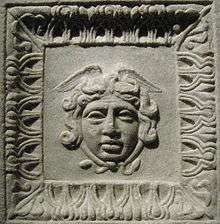
Here are archaeological items from Leeds and around the world.
- Roman floor mosaic ca 250 CE, depicting she-wolf with Romulus and Remus. This was discovered at Aldborough (Yorkshire), known to the Romans as Isurium Brigantum.
- Hellenistic Greek tomb doors ca 250 BCE. These are carved in marble, in bas relief.
- The Leeds Mummy. In the 1941 bombing raids, two other mummies were destroyed, but Nesyamun's 3000-year-old mummy survived. It is displayed in the current museum building, alongside a rather striking reconstruction of his face.[19]
- Iron replica of Hellenistic Greek head of Aphrodite. This is a cast replica of the original 1st century BCE head in the British Museum. The original was discovered in 1872 at Satala (now Sadak) in north-eastern Turkey. The eyes were once inlaid with precious stones or paste. Apparently the top of the head was not designed to be empty, like a piece of modern art. It seems that the farmer found it when he hit the top of the head with his axe and damaged it.[20]
World View gallery
In 2014 this gallery began hosting a long-term exhibition called 'Voices of Asia',[21][22] which celebrates the sights, sounds and culture of Asian communities here in Leeds and around the world. The 'faith' element of the display regularly changes. From 2017, the focus was on Buddhism.[23]
Leeds Museums & Galleries has large collection of objects from around the world, and Voices of Asia displays just one aspect of the city's holdings.[24] The Leeds African collections are also significant, especially the sculpture, masks and textiles. Since 2019, most are held at Leeds Discovery Centre, where you will also find good representations of North American beadwork, European folk items and the traditional arts of Oceania.[25]
Leeds Story gallery
The history of Leeds from prehistory to the modern day. One of the key objects on display is the Malham Pipe, originally identified as an Iron Age flute made from bone, its dating has been revised to the early medieval period.[26]
Special Exhibitions
On the third floor is a gallery space dedicated to a changing exhibition programme. One previous exhibition was 'Beavers to Weavers' looking at things created by creatures.[27]
Collectors Cabinet
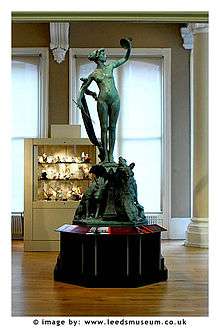
Various collections appear here in rotation with a focus on the people behind the objects.
- The Circe bronze by Alfred Drury. This was commissioned from Drury in 1894 by Leeds Art Gallery. It was displaced to Park Square in the 1950s when Victorian art went out of fashion. It was weathered and damaged, but has been restored recently.[28] It was Drury who made the eight beautiful bronze lampholder girls in Leeds City Square, plus the bronze of Joseph Priestley nearby.[29][30]
Former Curators
References
- Leeds Philosophical and Literary Society: About the society
- "Heritage Lottery Fund: History in the Making, 22 September 2005". Archived from the original on 27 April 2006. Retrieved 11 May 2009.
- Yorkshirepost.co.uk article: Long-awaited new museum set to go down in city's history Chris Bond, 12 September 2008.
- "Pilot project will piece together Leeds whale's tragic tale". www.yorkshireeveningpost.co.uk. Retrieved 5 December 2019.
- Norris, Adrian (1985). "Notes on the Natural History Collections in the Leeds City Museum. Number 5: The Leeds Tiger". Leeds Naturalists' Club Newsletter. 2:1: 19–20.
- Brears, Peter (1989). Of Curiosities & Rare Things: the story of Leeds City Museum. Leeds: The Friends of Leeds City Museum. ISBN 0-907588-077.
- Roles, John (2014). Director's Choice. London: Scala Arts and Heritage Publishers Limited. p. 29. ISBN 978-1-85759-840-7.
- "Leeds Philosophical Society: the conversazione". Leeds Mercury. British Newspaper Archive. 9 December 1863. p. 3 col 5. Retrieved 9 June 2020.
- "Death of Wm Gott Esq". Leeds Intelligencer. British Newspaper Archive. 29 August 1863. p. 5 col 2. Retrieved 9 June 2020.
- "Leeds Philosophical and Literary Society : Professor Owen's inaugural address". Leeds Mercury. British Newspaper Archive. 17 December 1862. p. 3 col 2. Retrieved 9 June 2020.
- "Leeds nostalgia: The story of the Leeds Tiger". Yorkshire Evening Post. JP Media. 31 December 2016. Retrieved 8 June 2020.
- "Leeds nostalgia: The story of the Leeds Tiger". Yorkshire Evening Post. JP Media. 31 December 2016. Retrieved 8 June 2020.
- Chrystal, Paul (2019). A-Z of Leeds: Places, People, History:L - Leeds City Museum. Leeds, England: Amberley Publishing Limited. ISBN 9781445689142. Retrieved 8 June 2020.
- Marte, Fernando; Pequignot, Amandine; Von Endt, David W. (2006). "Arsenic in taxidermy collections: history, detection and management" (PDF). pdfs.semanticscholar.org. Smithsonian Center for Materials Research. Retrieved 8 June 2020.
- Chestofbooks.com webpage: Arsenical soap.
- Chrystal, Paul (2016). Leeds in 50 Buildings: 9. Leeds City Museum 1819 Park Row. Leeds, England: Amberley Publishing Limited. ISBN 9781445654553. Retrieved 8 June 2020.
- "Visit to the art exhibition in the Leeds Philosophical Hall no.IV". Leeds Mercury. British Newspaper Archive. 2 January 1863. p. 4 col 1. Retrieved 9 June 2020.
- Andrew, Ebony Laura (2013). Interpreting Nature: Shifts in the Presentation and Display of Taxidermy in Contemporary Museums in Northern England (PDF) (Ph.D.). University of Leeds. p. 184. Retrieved 9 June 2020.
- 24dash.com: Sting in the tale of Leeds mummy, by Hannah Wooderson, 3 September 2008. Archived 3 April 2010 at the Wayback Machine
- Britishmuseum.org: Bronze head of a goddess, probably Aphrodite.
- "Voices of Asia". Leeds City Council.
- "Discover a world of Asian wonders behind Leeds museum's doors". Yorkshire Evening Post. 18 April 2014. Retrieved 6 June 2019.
- "Spotlight: the Voices of Asia". Religion in Public. Retrieved 6 June 2019.
- "Voices of Asia". Which Museum. Retrieved 25 September 2019.
- "World Cultures Collections". Leeds City Council. Retrieved 6 June 2019.
- Sermon, Richard; Todd, John F.J. (2 January 2018). "The Malham Pipe: A Reassessment of Its Context, Dating and Significance". Northern History. 55 (1): 5–43. doi:10.1080/0078172X.2018.1426178. ISSN 0078-172X.
- "Beavers to Weavers". Secret Lives of Objects. Retrieved 6 June 2019.
- Culture24: Leeds City Art Gallery Brings Victorian Statue In From The Cold 7 March 2008.
- A sculpture walk in Leeds.
- BBC.co.uk: Moving Statues